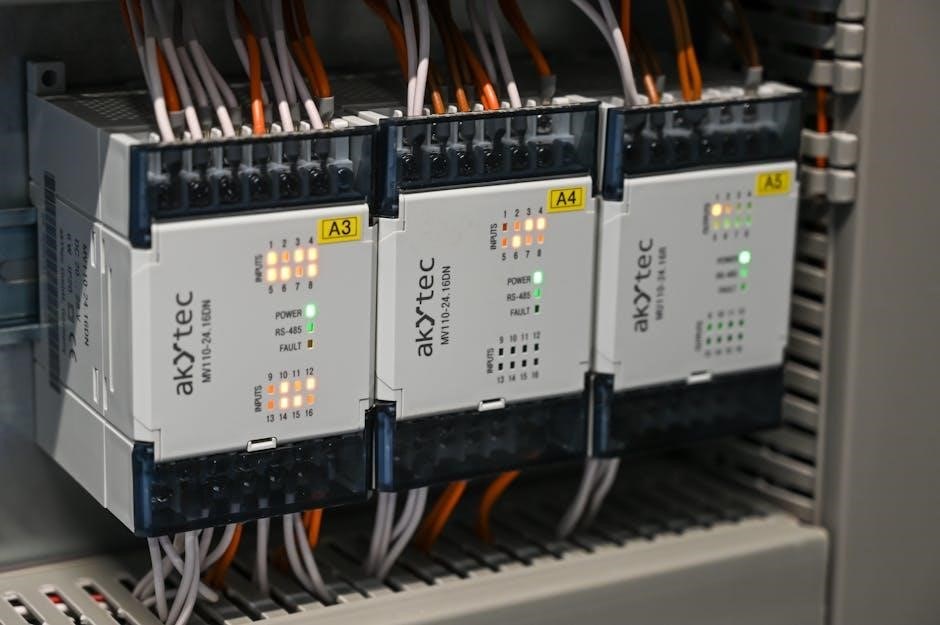The PowerFlex 755 drive’s fault codes are essential for diagnosing and resolving issues efficiently. This guide provides a comprehensive overview of these codes, ensuring smooth operation and quick troubleshooting, leveraging the detailed fault code list and diagnostic tools from the PDF resource.
What is the PowerFlex 755?
The PowerFlex 755 is a high-performance variable frequency drive (VFD) designed by Rockwell Automation for controlling and adjusting the speed of AC motors. It is widely used in industrial applications to optimize motor performance, reduce energy consumption, and enhance system efficiency. The drive supports a range of power ratings and is known for its advanced control capabilities, including customizable parameters and robust fault detection features. Its compact design and user-friendly interface make it a preferred choice for various industries, from manufacturing to water treatment. Understanding the PowerFlex 755 is crucial for diagnosing and resolving operational issues, as its fault codes provide detailed insights into system malfunctions, enabling timely and effective troubleshooting.
Importance of Understanding Fault Codes
Understanding PowerFlex 755 fault codes is critical for maintaining operational efficiency and minimizing downtime in industrial applications. Fault codes provide specific insights into system malfunctions, enabling quick diagnosis and resolution. By interpreting these codes, users can identify issues such as input phase loss, output phase loss, or motor overload, addressing problems before they escalate. The PowerFlex 755 fault codes PDF serves as a vital resource, offering detailed explanations and solutions for each code. This knowledge empowers technicians to perform targeted repairs, reducing the risk of further damage and ensuring smoother system operation. Regular review of fault codes also supports preventive maintenance, helping to identify potential issues early and improve overall system reliability.
Overview of the PowerFlex 755 Fault Codes PDF
The PowerFlex 755 Fault Codes PDF is a comprehensive resource designed to help users interpret and resolve drive-related issues efficiently. It includes a detailed fault code table, listing codes such as 16, 17, and 18, along with their descriptions and potential causes. The document is organized to provide quick access to critical information, ensuring minimal downtime during troubleshooting. Key sections include fault code explanations, diagnostic procedures, and recommended solutions. The PDF also covers alarm and event descriptions, configurable conditions, and guidance on manually clearing faults. With its clear structure and practical examples, the PowerFlex 755 Fault Codes PDF serves as an essential tool for technicians and operators, enabling them to identify and address issues promptly and effectively, ensuring optimal system performance and reliability.

Structure of the PowerFlex 755 Fault Codes PDF

The PowerFlex 755 Fault Codes PDF features a structured layout with fault code tables, input/output assembly details, and diagnostic guidance. It includes array tags for easy issue identification.

Table of Contents in the PDF
The PowerFlex 755 Fault Codes PDF begins with a detailed table of contents, organizing information for easy navigation. Key sections include fault code descriptions, alarm configurations, and troubleshooting guidance. The document outlines chapters dedicated to input and output assembly diagnostics, as well as specific fault conditions like phase loss and motor overload. It also covers advanced features such as HIM indication for fault display and manual fault clearing procedures. Additional sections focus on status indicators, configurable conditions, and event logging, providing a comprehensive resource for technicians. The table of contents ensures users can quickly locate relevant information, making the PDF an essential tool for efficient fault resolution and system maintenance.
Organization of Fault Codes
The PowerFlex 755 Fault Codes PDF organizes fault codes logically, making it easier to identify and address issues. Codes are categorized by type, such as input phase loss or motor overload, and grouped for quick reference. Each fault code is accompanied by detailed descriptions, causes, and solutions. The document uses specific tags like PF75x_FaultCodeList to structure fault data, ensuring consistency across templates. This organization allows technicians to quickly locate relevant information, reducing downtime. The PDF also separates alarm and event configurations, providing clear distinctions between system notifications. By systematically presenting fault codes and their resolutions, the PDF becomes an indispensable tool for diagnosing and resolving drive-related issues efficiently.
Key Sections to Focus On

The PowerFlex 755 Fault Codes PDF highlights several key sections that are essential for effective troubleshooting and maintenance. The Table of Contents provides a clear roadmap for navigating the document, while the Detailed Fault Code Explanations offer in-depth insights into each error. The Troubleshooting Guide is another critical section, offering step-by-step solutions for common issues; Additionally, the Preventive Maintenance Tips section helps users avoid potential problems. Focusing on these areas ensures that users can quickly identify, diagnose, and resolve faults efficiently. These sections are designed to maximize productivity and minimize downtime, making them indispensable for anyone working with the PowerFlex 755 drive.

Common PowerFlex 755 Fault Codes
The PowerFlex 755 frequently experiences fault codes such as 16 (Motor Overload), 17 (Input Phase Loss), and 18 (Output Phase Loss). These codes indicate issues like power supply problems or excessive motor load, requiring immediate attention to prevent damage. Understanding these codes is crucial for timely resolution and minimizing downtime. Detailed explanations and solutions for each code are provided in the PDF, ensuring users can address issues effectively. Regular monitoring and maintenance can help prevent these common faults. Refer to the specific sections for in-depth troubleshooting guidance.
Fault Code 17: Input Phase Loss
Fault Code 17 indicates an input phase loss in the PowerFlex 755 drive. This occurs when one or more phases of the incoming power supply are missing or disrupted. Common causes include faulty input wiring, loose connections, or issues with the power source. The drive detects this anomaly and triggers the fault to protect itself and the connected motor from potential damage. To resolve this, inspect the input wiring for damage or corrosion, ensure all connections are secure, and verify the power supply is stable. If the issue persists, check for failed components like fuses or circuit breakers. Resetting the drive after addressing the root cause typically clears the fault. Regular maintenance and inspections can help prevent this issue from recurring. Always refer to the PDF guide for detailed troubleshooting steps. Proper resolution ensures reliable operation and prevents further complications.
Fault Code 18: Output Phase Loss
Fault Code 18 in the PowerFlex 755 indicates an output phase loss, where one or more output phases are missing or disrupted. This issue typically occurs due to problems in the output wiring, such as damaged or loose connections, or a fault in the motor circuit. The drive detects this anomaly to prevent damage to the motor or internal components. To resolve this, inspect the output wiring for damage, ensure connections are secure, and verify the motor is functioning correctly. If the motor is damaged, repair or replacement may be necessary. Resetting the drive after addressing these issues usually clears the fault. Regular inspections and maintenance can help prevent such issues. Always consult the PowerFlex 755 Fault Codes PDF for detailed guidance. Addressing this promptly ensures smooth operation and avoids further complications.
Fault Code 16: Motor Overload
Fault Code 16 on the PowerFlex 755 indicates a motor overload condition, where the drive detects excessive current exceeding safe limits. This typically occurs when the motor is subjected to a higher load than its rated capacity or due to mechanical issues like jamming or misalignment. The drive halts operation to prevent damage to the motor or itself. To resolve this, reduce the load on the motor, check for mechanical obstructions, and ensure proper motor sizing. Overload conditions can also result from improper drive configuration or incorrect parameter settings. Resetting the drive after addressing these issues may resolve the fault. Regular monitoring of motor performance and load conditions can help prevent such occurrences. Always refer to the PowerFlex 755 Fault Codes PDF for detailed troubleshooting steps and recommendations. Addressing overload issues promptly ensures reliable operation and extends equipment lifespan.
Fault Code 17: Input Phase Loss Causes and Solutions
Fault Code 17 on the PowerFlex 755 indicates an input phase loss, where one or more phases of the incoming AC power supply are missing or not detected. Common causes include loose or disconnected power cables, blown fuses, tripped circuit breakers, or damaged phase conductors. Faulty or improperly configured input devices, such as contactors or circuit breakers, can also trigger this code. To resolve the issue, inspect the power supply lines for integrity, ensure all connections are secure, and verify that the circuit breakers or fuses are functioning correctly. If the problem persists, check for phase imbalance or electrical supply issues. Resetting the drive after correcting the power supply should clear the fault. Always consult the PowerFlex 755 Fault Codes PDF for detailed diagnostic procedures and safety guidelines. Regular electrical system inspections can help prevent such faults.
Fault Code 18: Output Phase Loss Causes and Solutions
Fault Code 18 on the PowerFlex 755 indicates an output phase loss, where one or more phases of the output power to the motor are missing or not detected. Common causes include faulty motor wiring, loose connections, or damaged motor windings. Additionally, blown fuses or tripped circuit breakers on the output side, as well as internal drive issues like faulty IGBTs or output modules, can trigger this fault. To resolve it, inspect the motor wiring for damage or looseness, verify output fuses and circuit breakers, and test motor windings for opens or shorts. If internal drive components are faulty, contact a qualified technician for repairs. Resetting the drive after addressing the issue should clear the fault. Always refer to the PowerFlex 755 Fault Codes PDF for precise troubleshooting steps and safety precautions. Regular inspections of motor and wiring systems can prevent such issues.
Fault Code 16: Motor Overload Causes and Solutions
Fault Code 16 on the PowerFlex 755 indicates a motor overload, where the drive detects excessive current exceeding the motor’s rated capacity. This can occur due to mechanical overloading, improper motor sizing, or high ambient temperatures affecting cooling efficiency. Additionally, incorrect parameter settings or insufficient ventilation in the drive’s environment may contribute. To resolve this, reduce the mechanical load on the motor, ensure proper cooling by maintaining airflow, and verify motor ratings match the application. Check parameter settings for accuracy and adjust if necessary. If the issue persists, consult the PowerFlex 755 Fault Codes PDF for detailed diagnostic steps. Regular monitoring of current levels and thermal conditions can help prevent future overloads. Addressing the root cause promptly prevents damage to both the motor and the drive.
Troubleshooting PowerFlex 755 Fault Codes
Troubleshooting PowerFlex 755 fault codes involves identifying the code, checking the PDF, using diagnostic tools, inspecting connections, and verifying power supply and load conditions. Clearing the fault and testing the system ensures proper operation.
Steps to Identify the Fault Code
To identify a PowerFlex 755 fault code, start by checking the drive’s display for the active fault code. Refer to the PowerFlex 755 fault codes PDF to find the specific code’s meaning. Review the code description to understand the issue. Next, examine the drive’s status and recent events using the keypad or software tools. Verify if the fault is active or historical. Check for multiple faults and prioritize them. Use the PDF to identify potential causes and recommended actions. Ensure proper connections, power supply, and load conditions. Clear the fault code after addressing the issue and test the system to confirm resolution. This systematic approach ensures accurate identification and effective troubleshooting.
Using the Fault Codes PDF for Diagnosis
The PowerFlex 755 fault codes PDF is an essential resource for diagnosing issues. Start by locating the specific fault code in the PDF’s table of contents. Refer to the code’s description to understand the issue. The PDF provides detailed explanations of possible causes and recommended actions. Use this information to identify potential system malfunctions, such as input or output phase loss, motor overload, or communication errors. Cross-reference the fault code with the drive’s status and recent events to pinpoint the root cause. Follow the troubleshooting steps outlined in the PDF to resolve the issue effectively. This method ensures a systematic approach to diagnosis, helping you address faults quickly and minimize downtime.

Common Tools for Troubleshooting
When troubleshooting PowerFlex 755 fault codes, several tools are essential for effective diagnosis. Rockwell Automation’s RSLogix 5000 and FactoryTalk View ME software are key for monitoring drive performance and accessing fault details. A multimeter is useful for checking voltage levels and verifying phase connections. An oscilloscope can help analyze waveforms to identify electrical issues. Communication tools like RS-232 or Ethernet cables enable connectivity to the drive for data extraction. The PowerFlex 755 fault codes PDF itself is a critical resource, providing code explanations and solutions. Additionally, Rockwell’s Knowledgebase and technical manuals offer deeper insights. By combining these tools, technicians can efficiently diagnose and resolve faults, ensuring minimal downtime and optimal system performance.
Best Practices for Fault Code Resolution
Resolving PowerFlex 755 fault codes requires a systematic and informed approach. Always start by consulting the fault codes PDF for detailed explanations and solutions. Prioritize understanding the root cause of the fault rather than just addressing symptoms. Use Rockwell Automation’s official documentation and software tools like RSLogix 5000 for accurate diagnostics. Regularly update firmware to ensure compatibility and resolve known issues. Maintain detailed records of faults and resolutions for future reference. Test repairs thoroughly before returning the system to operation. Additionally, implement preventive maintenance routines to minimize recurring faults. Collaborate with experienced technicians or Rockwell support for complex issues. By following these best practices, you can efficiently resolve faults and maximize system reliability. Consistency and attention to detail are key to effective fault code management.

Preventive Measures for PowerFlex 755 Faults
Implementing regular maintenance checks, updating firmware, monitoring environmental factors, ensuring proper installation, and documenting past faults are key to preventing PowerFlex 755 issues.
Regular Maintenance Checks
Regular maintenance checks are crucial for preventing PowerFlex 755 faults. Technicians should inspect power cables for wear or damage, clean dust from heat sinks, and ensure proper cooling. Checking for loose connections and verifying proper grounding can prevent phase loss faults. Monitoring temperature levels and ensuring adequate ventilation are essential to avoid overheating issues. Additionally, inspecting motor and load connections helps prevent overload conditions. Updating firmware and software regularly ensures compatibility and resolves potential bugs. Keeping a maintenance log and performing scheduled backups of drive configurations can also minimize downtime. Finally, verifying parameter settings and ensuring they match the application requirements helps maintain optimal performance and reduces the risk of unexpected faults. Regular maintenance not only extends equipment lifespan but also enhances overall system reliability and efficiency.
Updating Firmware and Software
Updating the PowerFlex 755 firmware and software is essential for optimal performance and fault prevention. Rockwell Automation regularly releases updates to fix bugs, improve functionality, and enhance compatibility with other devices. Ensure you download updates from the official Rockwell Automation website to avoid unauthorized or corrupted files. Before updating, back up your drive configurations and parameters to prevent data loss. Use compatible tools like RSLogix or FactoryTalk to perform the update, following the step-by-step instructions provided in the documentation. Regular updates can resolve known issues, add new features, and improve system security. Always verify the firmware version compatibility with your hardware to avoid installation errors. Keeping your system up-to-date ensures reliable operation and minimizes the risk of unexpected faults or downtime.
Environmental Factors to Monitor
Environmental factors play a significant role in the operation and reliability of the PowerFlex 755. Extreme temperatures, humidity, and dust can affect performance and lead to faults. Ensure the drive is installed in a climate-controlled environment, avoiding direct exposure to moisture or corrosive substances. Overheating can occur if the ambient temperature exceeds the recommended range, so proper ventilation and cooling systems are essential. Power quality issues, such as voltage spikes or harmonics, should also be monitored to prevent damage. Regularly inspect the drive for signs of environmental stress, such as corrosion or dust buildup, and clean as necessary. Adhering to Rockwell Automation’s environmental specifications helps minimize the risk of faults and ensures optimal operation. Monitoring these factors is crucial for preventing unexpected downtime and extending the lifespan of the PowerFlex 755.

Resources for PowerFlex 755 Fault Codes
The PowerFlex 755 Fault Codes PDF offers detailed fault explanations. Official Rockwell documentation and online forums provide tips. Third-party tools aid in diagnosis and resolution.
Official Rockwell Automation Documentation
The official Rockwell Automation documentation is the primary resource for understanding PowerFlex 755 fault codes. The PowerFlex 755 Fault Codes PDF is a comprehensive guide provided by Rockwell Automation, detailing fault code definitions, causes, and troubleshooting procedures. It includes detailed descriptions of each fault code, such as Fault Code 16, 17, and 18, along with recommended solutions. The document is structured to help users quickly identify and resolve issues, ensuring minimal downtime. Rockwell Automation regularly updates this documentation to reflect the latest firmware and hardware improvements. It is available for download from the official Rockwell Automation website, making it easily accessible for users. This resource is essential for technicians and engineers working with the PowerFlex 755 drive, as it provides authoritative and reliable information.
Online Forums and Communities
Online forums and communities are invaluable resources for addressing PowerFlex 755 fault codes. Platforms like Reddit, Stack Overflow, and specialized industrial automation forums often host discussions about common issues, including fault codes such as Fault Code 16, 17, and 18. These communities provide peer-to-peer support, where users share real-world experiences, solutions, and workarounds. Many technicians and engineers benefit from the collective knowledge shared in these spaces, especially for complex or less-documented issues. Additionally, Rockwell Automation’s official forums are a reliable source for verified solutions and expert advice. Participating in these communities can help users troubleshoot efficiently and gain insights from others who have encountered similar challenges. These forums are often updated regularly, making them a dynamic and valuable resource for resolving PowerFlex 755 fault codes.
Third-Party Tools and Software
Third-party tools and software can complement the PowerFlex 755 fault codes PDF by offering advanced diagnostic and troubleshooting capabilities. Tools like motor control centers (MCCs) and drive diagnostic software provide real-time monitoring and detailed fault analysis. Some third-party applications allow users to log historical data, enabling predictive maintenance and trend analysis. Additionally, software solutions like RSLogix or FactoryTalk can integrate with the PowerFlex 755, enhancing fault code interpretation and system optimization. While these tools are not substitutes for the official PDF, they can streamline troubleshooting and improve overall system performance. Always ensure third-party tools are compatible with the PowerFlex 755 and adhere to Rockwell Automation’s guidelines for safe and effective use.

The PowerFlex 755 fault codes PDF is an essential resource for diagnosing and resolving drive issues efficiently. Regular maintenance and updates ensure optimal performance and minimize downtime.
The PowerFlex 755 fault codes PDF serves as a comprehensive guide for understanding, diagnosing, and resolving drive-related issues. It provides detailed explanations of common fault codes, such as input phase loss, output phase loss, and motor overload, along with their causes and solutions. The document is structured to help users quickly identify and address problems, ensuring minimal downtime. Regular maintenance, firmware updates, and monitoring environmental factors are emphasized as preventive measures. Troubleshooting steps and the use of diagnostic tools are also highlighted to streamline fault resolution. By leveraging this resource, users can enhance their understanding of the PowerFlex 755 and improve overall system reliability and performance. Cross-referencing fault codes with solutions ensures efficient problem-solving.
Final Tips for Managing Fault Codes
Effectively managing PowerFlex 755 fault codes requires a proactive approach. Regularly review the fault codes PDF to familiarize yourself with common issues and their solutions. Always perform thorough diagnostics before attempting repairs, and use recommended tools to ensure accuracy. Documenting fault occurrences and resolutions can help identify recurring problems and improve long-term system reliability. Prioritize preventive maintenance, such as checking connections and updating firmware, to minimize downtime. When troubleshooting, refer to the PDF for specific guidance, and consult official resources or experts if needed. Consistent vigilance and adherence to best practices will enhance your ability to manage and resolve fault codes efficiently, ensuring optimal performance of the PowerFlex 755 drive.
